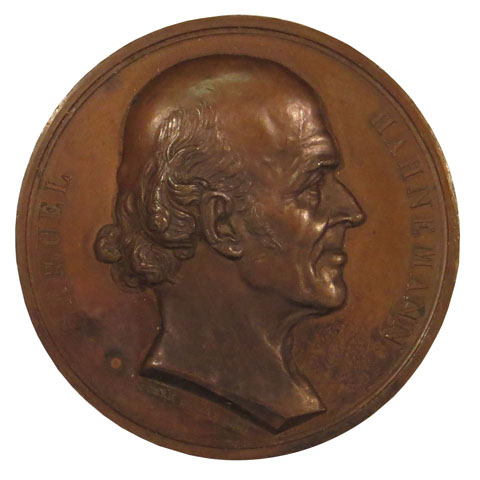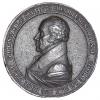Christian Samuel Hahnemann (1755-1843) earned a medical degree from University of Erlangen in Bavaria. He was a gifted linguist, and in his youth, worked as a multi-lingual translator. In 1779, he returned to his home state of Saxony, where he gave up the practice of medicine, again supporting himself as a translator and writer. He became an opponent of therapeutic venesection. While translating William Cullen’s medical textbook into German, Hahnemann learned that the cinchona bark of a Peruvian tree was effective in treating malaria. When he consumed the drug, he developed symptoms that he considered to be analogous to malaria. This became the principle of “similars,” a substance that causes symptoms that resemble those of a particular disease should ameliorate that disease. Around 1801, he began to experiment with the dilution and agitation of medicines to strengthen their effect. He introduced the term “homeopathy” in an 1807 essay. He is buried in Paris.
- Medal
Copper. France 1836. Signed. Lifetime. From French homeopaths honoring their master's coming to France.
- Size
50 mm
- Artist
Emile Rogat (1770-1850) French medallist Emile Rogat (1770-1850) French sculptor and medallist from Paris; his medallic productions are comprised between 1805-1850. (Forrer 5, 191)
- Obverse
Nude bust to right in high relief; below and parallel to truncation, EMILE ROGAT 1836.; in a curve at left and right, SAMUEL HAHNEMANN.
- Reverse
Around from lower left, NÉ A MEISSEN LE 10 AVRIL 1755, VENU EN FRANCE LE 25 JUIN 1835 / A LEUR MEITRE, LES HOMŒOPATHISTES FRANÇAIS. in two lines, with rosette at bottom; in reentrant serpent, SIMILIA / SIMILIBUS / CURENTUR in three lines.
- Edge
Paris mint mark (a pointing hand) and CUIVRE incused
- Ref
Freeman 222; Storer 1435; Nilsson 261




